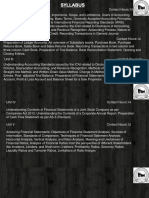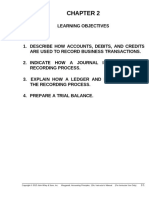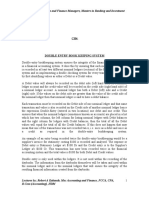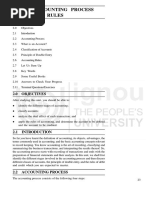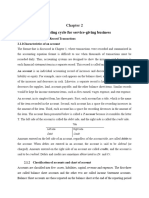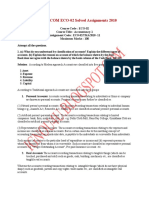Unit 3
Unit 3
Uploaded by
Linh Trang Nguyễn ThịCopyright:
Available Formats
Unit 3
Unit 3
Uploaded by
Linh Trang Nguyễn ThịCopyright
Available Formats
Share this document
Did you find this document useful?
Is this content inappropriate?
Copyright:
Available Formats
Unit 3
Unit 3
Uploaded by
Linh Trang Nguyễn ThịCopyright:
Available Formats
Unit 3
BOOKKEEPING
Overview
In this unit, students will be provided knowledge about bookkeeping, the basic system
of bookkeeping and its responsibility in the organization’s system of financial
information.
Learning objectives
After this unit, students should be able to:
>> Understand meaning and the aims of bookkeeping
>> Outline the double-entry system of bookkeeping
Think and discuss
1. What is bookkepping?
2. What are the aims of bookkepping?
English for accounting 36
1. SPECIAL TERMS
Match the words or expressions in the column A with their definition in column
B. You can look it up for more detailed explanations in specialist dictionary.
Column A Column B
A. the labels used by accountants to accumulate
1. Journal
the amounts produced from similar transactions.
B. the accounting system in which each
2. Ledger transaction has a corresponding positive and
negative entry (debits and credits)
C. A list of account numbers with corresponding
3. Accounts
account names of an organization.
D. The process of recording financial data by
4. Debit
writing down the details of transactions
E. the simplest form of an account, used to analyze
5. Credit
transactions
F. A comparison of the total of debit and credit
6. Double-entry balances in the accounts to check that they are
equal
G. the book of original entry in chronological
7. T-accounts
order.
8. Chart of accounts H. The book of final entry
9. Bookkeeping I. the left side of an account
10. Trial balance J. the right side of an account
K. An amount of goods stored for sale, in
11. Cash accounting, the value of raw materials, work in
progress, and finished but unsold products.
L. Amounts due to employees for wages earned
12. Accounts receivable but not paid.
M. Accounts contain the amounts owed to
13. Inventory suppliers for invoices that have been approved and
entered for payment.
N. A right to receive an amount as the result of
14. Accounts payable delivering goods or services on credit.
O. Money and any medium of exchange including
15. Wage payable coins, currency, checking account balances, petty
cash funds, and money deposit in a bank.
English for accounting 37
2. READING
READING 1
Reading text 1: Bookkeeping and do exercise 2.1 below
BOOKKEPPING
Bookkeeping is an essential accounting tool. A small business or company may
employ only one bookkeeper, who records all of the financial data by hand; large
organizations may employ many bookkeepers, who use electronic and mechanical
equipment for a large part of their work. Each organization has its own bookkeeping
requirements, but all systems operate on the same basic principles. The bookkeepers
themselves must be accurate, good at math, and meticulous; that is, they must be very
careful to record each detail in its proper place.
The two basic systems of bookkeeping are double-entry and single-entry. The
double-entry method was perfected by the merchants of Venice during the fifteenth century
and is still used today. The basic principle of double-entry bookkeeping is that every
transaction has a two-fold effect. In other words, a value is received and a value is yielded
or parted with. Both effects, which are equal in amount, must be entered completely in the
bookkeeping records.
An account is a record of the financial transactions that concern one item or a group
of similar items. The account includes categories of financial data for each area of interest
during a specific period: the value at the beginning of the period, changes in value during
the same period, and the value at the end of the period. The broad areas of interest can be
labeled as assets, liabilities, and net worth. At regular intervals, the income and expense
accounts are totaled, and the resulting profit or loss is posted to a capital account.
Anything of value that a business or organization owns is commonly known as an
asset. Asset accounts include cash, which is the money on hand or in the bank; furniture
and fixtures, such as equipment and buildings; accounts receivable, the claims against
customers that owe money; stock or inventory; supplies; and many others that show what
the organization owns.
Debts owed to creditors are known as liabilities. If money is owed to an organization
or person for things or services purchased on credit, this liability is called an account
payable. Other liabilities include wages or salaries that are owed to employees, or taxes
that have not yet been paid.
A separate account is kept for each asset, liability, and capital item so that
information can be recorded for each of them. Accounts are also maintained for income
and for expenses, and like assets, liabilities, or capital. These accounts are also entered into
the ledger, which is a detailed listing of all the accounts of an organization. Entries from
English for accounting 38
all the journals are transferred to the ledger at regular intervals. This process, called
"posting", is usually done monthly.
Journals, or books of original entries, are designed to record information about
different transactions, including sales, purchases, cash receipts, cash disbursements, and
many others. Journals have two or more columns to read, with increases or decreases in
the accounts affected by the transaction, and they often have space for a date and an
explanation of the transaction.
All transactions affect at least two accounts. Each transaction must be analyzed to
determine which account is a debit, while an entry made on the right-hand side or column
is a credit. Debit, usually abbreviated DR, at one time meant value received, or literally he
owes. Credit, usually abbreviated as CR, means value parted with, or literally, he trusts. In
modern bookkeeping, debit refers only to the left-hand side of an account, whereas credit
refers to the right-hand column to keep an up-to-date balance on the account.
Regularly and at fixed intervals, usually monthly, the bookkeeper posts all the
entries from each journal to the appropriate account in the general ledger. The bookkeeper
then foots, or totals, the columns of each account, that is, he or she adds the amounts of the
debits and credits and records the balance of each account. Since debits are always recorded
in amounts equal to credits, the debits and credits should always equal each other. The test
that determines whether the total of debits equals the total of credits is called a trial balance.
If the accounts are not balanced, some errors have been made which the bookkeeper must
find and correct.
The second basic system of bookkeeping, as mentioned previously, is the single-
entry method. This method refers to any system that does not include the complete results
of every transaction. The most common type of single-entry bookkeeping involves records
of cash, accounts receivable, and accounts payable.
Many bookkeeping systems include journals and records for specific types of
transactions. Special purchase books, for example, include invoices and voucher registers.
Invoices are itemized statements of merchandise sold to a customer. They list the quantity
and the charges. Vouchers are bills for the cash disbursement register, which records the
details of all checks written: to whom, when, how much, and for what purpose. Another
popular journal is the cash receipts journal, in which all payments received are recorded.
Bookkeepers are also responsible for maintaining the records of a company,
including, of course, the computation of taxes that are to be deducted and withheld, and the
completion of government forms that are required for tax and other employment purposes.
In a small company, the bookkeeper may also function as a cashier, as an assitant to the
manager, or in any number of clerical jobs. Regardless of the size of the operation, the
bookkeeper is a key person in the organization’s system of financial information.
(Source: Bich Van & Trong Thuy. 2001. The Language of Accounting in English,
Hanoi: Thong Ke Publisher)
English for accounting 39
2.1 Answer the following question based on the information in text 1
1. What are some of the basic requirements for a bookkeeper?
2. What are the two basic methods of bookkeeping?
3. What is the double-entry method’s basic principle?
4. What is an account? What are the three categories of financial data listed in an
account?
5. What is the difference between an asset and a liability?
6. What is a ledger? What kinds of accounts are entered into it?
7. What information is recorded in journals?
8. What does it mean if the debits and credits in a ledger are not balanced?
9. What is not included in single-entry bookkeeping?
10. Why is a bookkeeper a key person in an organization?
READING 2
Reading text 2: Effects of debits and credits on accounts and do exercise 2.2 below
EFFECTS OF DEBITS AND CREDITS ON ACCOUNTS
To keep a company's financial data organized, accountants developed a system that
sorts transactions into records called accounts. When a company's accounting system is set
up, the accounts most likely to be affected by the company's transactions are identified and
listed out. This list is referred to as the company's chart of accounts. Depending on the size
of a company and the complexity of its business operations, the chart of accounts may list
as few as thirty accounts or as many as thousands. The accounts are usually arranged into
general categories as asset accounts, liabilities accounts, owner’s equity accounts, expenses
and revenue accounts.
To assist in visualizing the effect of recording a debit or credit amount and the
resulting balances of general ledger accounts, it is helpful to draw a T-account, as shown
here:
Account title
Debit Credit
(Left side) (Right side)
T-account is so called because it has the form of letter T. The title of the account
will appear at the top of each "T". The left side of the T account is called a debit, and the
right side is called a credit. The terms debit or credit does not mean increase or decrease.
Whether a debit or credit is an increase depends on the account. In an account where a
English for accounting 40
debit is an increase, the credit is a decerase; in an account where a debit is a decrease, the
credit is an incerase. The difference between total debits and total credits for an account is
the account balance. When the sum of debits exceeds the sum of credits, the account has a
debit balance. It has a credit balance when the sum of credits exceeds the sum of debits.
When the sum of debits equals the sum of credits, the account has a zero balance.
The following table summarizes how debits and credits are used in the account.
Type of account Normal balance To increase To decrease
Assets Debit Debit Credit
Liabilities Credit Credit Debit
Owner’s equity Credit Credit Debit
Revenues Zero balance Credit Debit
Expenses Zero balance Debit Credit
Double-entry accounting requires that each transaction affects at least two accounts.
For each transaction, one or more accounts must be debited and one or more accounts must
be credited, and total debits must equal total credits. For example, when a company pays
$1,000 for equipment, its Cash account and its Equipment account will be affected. The
transaction could be depicted with the following T-accounts:
Equipment Cash
$ 1,000 $ 1,000
(debit) (credit) (debit) (credit)
Cash account has a debit $1,000 and Equipment account has a credit amount of
$1,000. Hence, the transaction had debits equal to credits.
The double-entry rules can be helpful when we need to find a mistake in financial
records. If total debits do not equal total credits, there must be a mistake. However, this
system cannot ensure complete accuracy. For example, even if debit balances equal credit
ones, an error may still be present because a wrong account was debited (or credited) when
the entry was made.
(Source: https://www.accountingcoach.com/)
2.2 Decide whether the following sentences are True (T) or False (F)
T/F
1. Debit always mean in crease and credit always mean decrease.
English for accounting 41
2. Double-entry accounting requires that all transactions that create debits to
asset accounts must create credits to liability or owner’s equity accounts.
3. When an expense is involved in a transaction, an expense account will be
debited.
4. The accountant's word to indicate that an entry will be recorded on the left
side of an account is credit.
5. Debit entries increase asset accounts, and decrease liability and equity
accounts.
3. LISTENING
3.1 You are going to listen the bookkeeper’s blog. Listen carefully and fill in
each blank with the information you hear.
Getting Back to Basics
Let’s review the basic bookkeeping cycle. No matter what type of
organization you work in, there are six steps.
1. (1) …………… source documents for all transactions. These include:
Purchase (2) ……………
Payroll Master Files
Time cards
Credit card statements
(3)
2. …………… the financial (4) …………… of every transaction. Typical
transactions include:
Payroll
Sales
(5) ……………
3. Record financial effects in a (6) ……………. Then (7) …………… them in the
accounting software.
4. (8) …………… end-of-period procedures:
Count inventory
Check for errors in classification
Adjust for errors
5. Prepare an adjusted (9) ……………
6. Close the books at the end of every (10) …………… year.
English for accounting 42
3.2
Listen again and choose the correct answers
1. What is the passage mainly about?
A. end-of-period procedures
B. minimizing financial effects
C. steps in the bookkeeping cycle
D. how to gather source documents
2 According to the passage, which is NOT a source document?
A. credit card statement
B. purchase invoice
C. accounting software and
D. payroll master files
3 What is true according to the passage?
A. Every organization follows a different bookkeeping cycle.
B. Financial effects are recorded in two different places.
C. Adiusted trial balances camy over to the next fiscal year.
D. Accounting software citales most source documents.
4. VOCABULARY EXERCISES
4.1 Complete the crossword. Look at two texts above on Reading part to
help you
English for accounting 43
Across
1. A business deal or action, such as buying or sellin something
3. A piece of paper that shows that goods or services have been paid for
5. The act of transferring an entry or item from a book of original entry to the proper
account in a ledger.
6. A book containing accounts to which debits and credits are posted from books of original
entry.
Down
2. A record in an accounting system that tracks the financial activities of a specific asset,
liability, equity, revenue, or expense
4. A book of transactions recorded in a chronological order
4.2 Complete the paragraph with the corret words from the box.
credits debits double-entry invoice
journals ledger posted receipt
transactions transferred trial balance vourchers
Bookkeepers record every purchase and sale that a business makes, in the order that
they take place, in (1) ............................... At a later date, these temporary records are
entered in or (2) .............................. to the relevant account book or (3) ...............................
Of course, the “books” these days are likely to be computer files. At the end of an
accounting period, all the relevant totals are (4) .............................. to the profit and loss
account. (5) .............................. bookkeeping records the dual effect of every transaction –
a value both received and parted with. Payments made or (6) .............................. are entered
on the left-hand (debtor) side of an account, and payments received or (7) ..............................
on the right-hand side. Bookkeepers will periodically do a (8) .............................. to test
whether both sides of an account book match. In most business (9) .....................................,
the seller of goods or services sends the buyer a bill or (10) .............................., and later a
(11)
............................ acknowledging payment. Businesses are obliged to retain the
documents – known as (12) .............................. – that support or prove an item in an account,
and make them available to the internal and external auditors who check the accounts.
Bookkeepers are not to be confused with librarians, who also keep books, or with
bookmakers, who ‘make books’ in the sense that they accept bets (on horse races, etc.) and
traditionally wrote them down in a book like a bookkeeper’s journal. Accountants, unlike
bookkeepers, analyze financial records and decide how to present them.
English for accounting 44
4.3 Match the words form a-j with similar meanings from 1-10
a. liablilty f. account
b. credit g. asset
c. journal h. debit
d. post i. ledger
e. footing j. trial balance
1. a book of orginal entries
2. the book that lists all of the accounts
3. that which is owned by an organization
4. present obligation of a business to pay cash, transfer assets, or provide services to other
entities in the future
5. the right-hand side of an account
6. the left-hand side of an account
7. the total of each side of an account
8. the test balance of the accounts
9. the basic storage unit for accounting data
10. to transfer entries from the journal to the ledger
1….2….3….4….5….6….7….8….9….10….
4.4 Complete the text with the correct form of the word in parentheses.
Bookkeeping is the (1) …………… (RECORD) of financial transactions.
Transactions include sales, purchases, income, (2) …………… (RECEIVE) and payments
by an individual or organization. Bookkeeping is usually done by a bookkeeper. Many
people make (3) …………… (MISTAKE) when they consider bookkeeping and
accounting to be the same thing. This confusion is (4) …………… (UNDERSTAND)
because the accounting process includes the bookkeeping function, which is just one part
of the accounting process. The accountant creates reports from the recorded (5)
……………(FINANCE) transactions recorded by the bookkeeper and files forms with
government agencies. There are some common methods of bookkeeping, such as the
single-entry bookkeeping system and the double-entry bookkeeping system. But while
these systems may be seen as "real" bookkeeping, any process that involves the recording
of financial transactions is a bookkeeping process.
English for accounting 45
A bookkeeper, also (6) …………… (KNOW) as an accounting clerk or accounting
technician, is a person who records the day-to-day transactions of an organization. A
bookkeeper is usually (7) …………… (RESPONSIBILITY) for writing the "daybooks".
The daybooks consist of purchases, sales, receipts, and payments. The bookkeeper is
responsible for (8) …………… (ENSURE) that all transactions are (9)
……………(RECORD) in the correct day book, supplier ledger, customer ledger and
general ledger.
The bookkeeper brings the books to the trial balance stage. An accountant may
prepare the income statement and balance sheet using the trial balance and ledgers (10)
……………(PREPARE) by the bookkeeper.
4.5 Complete these sentences using the correct words
1. Generally, when an expense is involved in a transaction, an expense account
will be ……………
2. The accountant’s word to indicate that an entry will be recorded on the left side
of an account is ……………
3. A ……………amount will appear on the right side of a T-account.
4. A listing of the balances in the accounts in order to determine whether debits are
equal to credits is a …………… balance
5. The listing of accounts that are available for posting transactions is the
…………… of accounts.
6. Liability accounts will normally have …………… balances.
7. The book of original entry is the definition of a ……………
8. Credits are entered on the …………. side of a T-account.
9. Asset account balances are reduced by a …………… entry
10. The requirement that each journal entry needs to have at least one debit and
one credit is known as …………… bookkeeping.
5. SPEAKING
5.1 Individual work
Based on the information in two texts above, answer the following questions
with your own words
1. What is bookkeeping? What are the aims of bookkeeping?
2. What is the double-entry system?
3. What is trial balance?
English for accounting 46
4. What is the difference between a journal and a ledger?
5. What’s T-account like?
5.2 Pair work or group work
Work with your partner(s) and discuss your answers
Being an effective group member
Asking for clarification
Sorry, what did you say?
Sorry, what was that?
What’s that again?
What do you mean?
I didn’t get that
Asking someone to repeat
Pardon me?
Excuse me?
Could you say that again?
Giving clarification
I’m talking about…
I’m saying that…
What I mean is…
6. WRITING
6.1 Rearrange the following words to make complete sentences
1. must/the bookkeepers/be/very/to/careful/record/each/its proper/detail/in/place.
………………………………………………………………………………………
2. the basic/ is/ principle/ double-entry/ bookkeeping/ that/ has /every/ transaction/
a/ of/ two-fold effect.
………………………………………………………………………………………
3. equal/used/check whether/the trial balance/is/ debit account/credit/to/and/
balances/ are.
………………………………………………………………………………………
4. assets/amount/remaining/is/the/owner’s equity/liabilities/from/are/after/deducted.
………………………………………………………………………………………
English for accounting 47
5. double-entry system/ for/ system/ recording/ transactions/the/ been/ recognized/
as/ financial/has/a.
………………………………………………………………………………………
6.2 Complete the following sentences using the given words.
1. Large organization/ may/ employ/ many/ bookkeeper /who/ use/ electronic/
mechanical/equipment/a large/part/their work.
………………………………………………………………………………………
……………………………………………………………………………………………...
2.Each/organization/have/own/bookkeeping/requirements/but/all/system/operate/
the same/basic/principles.
………………………………………………………………………………………
……………………………………………………………………………………………...
3. Accountants/develop/system/sort/transaction/into/record/call/account.
………………………………………………………………………………………
……………………………………………………………………………………………...
4. An account balance/difference/between/debit/and/credit/an/account.
………………………………………………………………………………………
……………………………………………………………………………………………...
5. T-account/tool/use/to/show/effect/of/transaction/and/event/on/individual/accounts.
………………………………………………………………………………………
……………………………………………………………………………………………...
6.3 Translate the following passage into Vietnamese
1. Whether bookkeeping tasks are performed manually by a bookkeeper or
electronically by clerks, one thing remains the same: every business transaction involves
at least two accounts. This is known as "double entry bookkeeping" (or "double entry
accounting"). Double entry bookkeeping requires that for each transaction, one (or more)
account must be debited, and one (or more) account must be credited.
………………………………………………………………………………………
……………………………………………………………………………………………...
2. The bookkeeper is responsible for ensuring all transactions are recorded in the
correct day book, supplier ledger, customer ledger and general ledger.
………………………………………………………………………………………
……………………………………………………………………………………………...
3. The creation of financial transactions includes posting information to accounting
journals or accounting software from such source documents as invoices to customers, cash
receipts and supplier invoices.
English for accounting 48
………………………………………………………………………………………
……………………………………………………………………………………………...
4. Accountants and bookkeepers often use T-accounts as a visual aid to see the effect
of a transaction or journal entry on the two (or more) accounts involved. The layout of T-
account title on top, a left or debit side, and a right or credit side.
………………………………………………………………………………………
……………………………………………………………………………………………...
5. Asset accounts are one of the three major classifications of accounts. They are
usually listed first in the company's chart of accounts and will normally have debit
balances.
………………………………………………………………………………………
……………………………………………………………………………………………...
6.4 Translate the following sentences in to English
1. Tài khoản là nơi lưu trữ cơ bản các dữ liệu của kế toán về các nghiệp vụ cùng
loại.
………………………………………………………………………………………
……………………………………………………………………………………………..
2. Hệ thống ghi kép, là nền tảng của kế toán yêu cầu mỗi nghiệp vụ kinh tế phải
được ghi chép vào ít nhất hai tài khoản, một tài khoản ghi Nợ, một tài khoản ghi Có.
………………………………………………………………………………………
……………………………………………………………………………………………..
3. Sổ nhật ký dùng để ghi chép chi tiết mỗi nghiệp vụ phát sinh, trong khi sổ cái
tài khoản dùng để cập nhật số liệu của mỗi tài khoản. Nghiệp vụ được ghi chép vào nhật
ký sau đó sẽ được chuyển vào tài khoản tương ứng trong sổ cái.
………………………………………………………………………………………
……………………………………………………………………………………………..
4. Chuyển sổ là việc chuyển thông tin từ nhật ký vào sổ cái tài khoản và được thực
hiện hàng ngày hay định kỳ tùy theo nghiệp vụ phát sinh nhiều hay ít.
………………………………………………………………………………………
……………………………………………………………………………………………...
5. Theo hệ thống kế toán kép, với mỗi số tiền được ghi Nợ, đều có một số tiền bằng
như vậy được ghi Có, do đó tổng số tiền ghi Nợ luôn bằng tổng số tiền ghi Có trên các tài
khoản.
………………………………………………………………………………………
……………………………………………………………………………………………...
English for accounting 49
You might also like
- Financial Accounting-Short Answers Revision NotesDocument26 pagesFinancial Accounting-Short Answers Revision Notesfathimathabasum91% (11)
- Gibbons Solution Problem Set 1.5 1.7 & 1. 8Document8 pagesGibbons Solution Problem Set 1.5 1.7 & 1. 8senopee100% (2)
- Hotel AccountingDocument30 pagesHotel AccountingTitem Ashenafi Berta50% (2)
- Hiab 322 Hiduo: Capacity 30 TMDocument2 pagesHiab 322 Hiduo: Capacity 30 TMjose_raico2285No ratings yet
- Chapter 3Document14 pagesChapter 3Anjelika ViescaNo ratings yet
- Acct 4Document5 pagesAcct 4Annie RapanutNo ratings yet
- Answer: Book-Keeping Is Mainly Concerned With Record Keeping orDocument7 pagesAnswer: Book-Keeping Is Mainly Concerned With Record Keeping orRisha RoyNo ratings yet
- RECORDING OF BUSINESS TRANSACTION - Copy MSHINDODocument11 pagesRECORDING OF BUSINESS TRANSACTION - Copy MSHINDOobedygeorge2003No ratings yet
- Unit-4 Financial Accounting HandoutDocument12 pagesUnit-4 Financial Accounting Handout22wh1a1231No ratings yet
- Untitled 11122@@@Document9 pagesUntitled 11122@@@freefireselaiyarasuNo ratings yet
- Chapter 1Document5 pagesChapter 1palash khannaNo ratings yet
- MEFA - 4th UnitDocument24 pagesMEFA - 4th UnitP.V.S. VEERANJANEYULUNo ratings yet
- Unit 1 TAPDocument19 pagesUnit 1 TAPchethanraaz_66574068No ratings yet
- CHAPTER 2 - Accounting CycleDocument11 pagesCHAPTER 2 - Accounting CycleFranz Josef MereteNo ratings yet
- TOPIC TWODocument8 pagesTOPIC TWOtogiya5800No ratings yet
- ACCT 1026 Lesson 4 PDFDocument5 pagesACCT 1026 Lesson 4 PDFAnnie RapanutNo ratings yet
- Qtr.-2-Week-7-EntrepDocument54 pagesQtr.-2-Week-7-Entrepaumentadostephanie80No ratings yet
- Financial Accounting Short Answers Revision NotesDocument26 pagesFinancial Accounting Short Answers Revision NotesRR SarkarNo ratings yet
- Chapter 4 - JournalDocument40 pagesChapter 4 - JournalPai100% (4)
- Chapter 2Document10 pagesChapter 2mayhipolito01No ratings yet
- Diaz. Chapter 3Document3 pagesDiaz. Chapter 3PangitkaNo ratings yet
- Chapter 3 - Class 11 NCERT Accounts Recording of Transaction 1Document8 pagesChapter 3 - Class 11 NCERT Accounts Recording of Transaction 1Arvind KumarNo ratings yet
- Unit 2Document69 pagesUnit 2Simardeep SalujaNo ratings yet
- Entrepreneurship Q2 Week 7Document13 pagesEntrepreneurship Q2 Week 7Nizel Sherlyn NarsicoNo ratings yet
- Fmea 4 UnitDocument50 pagesFmea 4 Unitaschandrawat357No ratings yet
- Question SheetDocument7 pagesQuestion Sheetscientistmonster0001No ratings yet
- Acc CH 2Document10 pagesAcc CH 2Tajudin Abba RagooNo ratings yet
- Binayak Academy,: Gandhi Nagar 1 Line, Near NCC Office, BerhampurDocument16 pagesBinayak Academy,: Gandhi Nagar 1 Line, Near NCC Office, BerhampurkunjapNo ratings yet
- FA-I (Lecture Note Ch-2)Document51 pagesFA-I (Lecture Note Ch-2)samioro746No ratings yet
- Steps in Accounting CycleDocument34 pagesSteps in Accounting Cycleahmad100% (4)
- What Is A Journal Entry in AccountingDocument20 pagesWhat Is A Journal Entry in AccountingIc Abacan100% (1)
- 2 The Recording ProcessDocument2 pages2 The Recording ProcessMa. Franceska Loiz T. RiveraNo ratings yet
- What Is AccountsDocument9 pagesWhat Is AccountsRishi_Sachdev_6020No ratings yet
- Financial Accounting - IntroDocument16 pagesFinancial Accounting - Introaiswarya sNo ratings yet
- FA AssignmentDocument26 pagesFA AssignmentMoh'ed A. KhalafNo ratings yet
- ch02 The Recording ProcessDocument12 pagesch02 The Recording ProcessMạnh Hoàng Phi ĐứcNo ratings yet
- Work Italian Cash BookDocument19 pagesWork Italian Cash BookScribdTranslationsNo ratings yet
- Fundamental ch-2Document27 pagesFundamental ch-2senaashe7No ratings yet
- Double Entry Book Keeping System Notes (Autorecovered)Document6 pagesDouble Entry Book Keeping System Notes (Autorecovered)Hamdi Omar Osman100% (1)
- Bca Fam Unit 2Document21 pagesBca Fam Unit 2ayushsingh96510No ratings yet
- 2019 2 17 Presentation 2Document56 pages2019 2 17 Presentation 2ahmetNo ratings yet
- Theory FA1Document27 pagesTheory FA1talha ShakeelNo ratings yet
- Financial Accountancy Chapter 4 Notes PDFDocument55 pagesFinancial Accountancy Chapter 4 Notes PDFHarshavardhanNo ratings yet
- Business Finance: Mrs. Leah O. RualesDocument28 pagesBusiness Finance: Mrs. Leah O. RualesCleofe Sobiaco100% (1)
- Accounting Concepts and Conventions: Unit - IDocument30 pagesAccounting Concepts and Conventions: Unit - IGopal KrishnanNo ratings yet
- Journal or Day BookDocument42 pagesJournal or Day BookRaviSankar100% (1)
- Unit-2 Accounting Process and RulesDocument14 pagesUnit-2 Accounting Process and RulesSameer XalkhoNo ratings yet
- Accounting Manual On Double Entry System of AccountingDocument12 pagesAccounting Manual On Double Entry System of AccountingGaurav TrivediNo ratings yet
- Chapter Two The Accountig CycleDocument20 pagesChapter Two The Accountig Cyclehayelom50% (4)
- Chapter 2 Fundamental 1Document28 pagesChapter 2 Fundamental 1samita2721No ratings yet
- Entrepreneurship: Chart of Accounts/ JournalizingDocument8 pagesEntrepreneurship: Chart of Accounts/ JournalizingSeigfred SeverinoNo ratings yet
- Accounting Handout 1Document3 pagesAccounting Handout 1Wahyu Gus PratamaNo ratings yet
- INFORMATION SHEET 1 Entrep 4thDocument22 pagesINFORMATION SHEET 1 Entrep 4thAndrea Mae CenizalNo ratings yet
- Chapter 2Document7 pagesChapter 2DoostMohammad HellalNo ratings yet
- Accounts Journalstotrialbalance 121017052242 Phpapp02Document23 pagesAccounts Journalstotrialbalance 121017052242 Phpapp02ustino imoNo ratings yet
- BookkeepingDocument23 pagesBookkeepingJane Mica CavalidaNo ratings yet
- 2.2 - LedgerDocument3 pages2.2 - LedgerABHAYNo ratings yet
- IGNOU B.com ECO-02 Solved Assignments 2010Document7 pagesIGNOU B.com ECO-02 Solved Assignments 2010Ankit BhardwajaNo ratings yet
- MBA SEM.1 Recording of TransactionsDocument24 pagesMBA SEM.1 Recording of Transactionsprashantmis452No ratings yet
- Accounting For Service Business-MS Teams (Slide1-40)Document40 pagesAccounting For Service Business-MS Teams (Slide1-40)alexandrakristinelazoNo ratings yet
- Acc CH 3 and CH 4Document7 pagesAcc CH 3 and CH 4elonreevemusk2kNo ratings yet
- Bookkeeping 101 For Business Professionals | Increase Your Accounting Skills And Create More Financial Stability And WealthFrom EverandBookkeeping 101 For Business Professionals | Increase Your Accounting Skills And Create More Financial Stability And WealthNo ratings yet
- MGEBJ21-1 - End Term Question PaperDocument3 pagesMGEBJ21-1 - End Term Question PapermikeNo ratings yet
- Integer Autoregressive Models With Structural BreaksDocument18 pagesInteger Autoregressive Models With Structural BreaksAkanksha KashikarNo ratings yet
- Download ebooks file (eBook PDF) Principles Of Microeconomics 3rd edition by Robert Frank all chaptersDocument51 pagesDownload ebooks file (eBook PDF) Principles Of Microeconomics 3rd edition by Robert Frank all chapterskobergsideeg100% (2)
- MONOPOLY WPS OfficeDocument10 pagesMONOPOLY WPS OfficeVen ClariseNo ratings yet
- Operation ResearchDocument15 pagesOperation ResearchD RAJUNo ratings yet
- Decision Lab Best F&B Rankings 2024Document17 pagesDecision Lab Best F&B Rankings 2024trang.taNo ratings yet
- Nabteb May June 2024 Time TableDocument4 pagesNabteb May June 2024 Time Table7q895y58ph100% (3)
- SUMMARYDocument6 pagesSUMMARYyash300997No ratings yet
- M30 Normal - Mix Design With Trial SheetDocument4 pagesM30 Normal - Mix Design With Trial Sheetabir sengupta100% (1)
- Present Value TableDocument2 pagesPresent Value TableCard CardNo ratings yet
- Matadi Express Vge315sDocument58 pagesMatadi Express Vge315sheritier mbomboNo ratings yet
- PESCO Online Bill Jun23Document1 pagePESCO Online Bill Jun23Muhammad AftabNo ratings yet
- G.R. No. 188767 (July 24, 2013) Spouses Argovan and Florida Gaditano San Miguel Corporation FactsDocument1 pageG.R. No. 188767 (July 24, 2013) Spouses Argovan and Florida Gaditano San Miguel Corporation FactsBlanche Penesa0% (1)
- 02 Manufacturing ProcessDocument27 pages02 Manufacturing ProcessIbrahim ManaluNo ratings yet
- Demand AbigailDocument2 pagesDemand AbigailJohn GuillermoNo ratings yet
- Electricity Bill Bahria Town LahoreDocument1 pageElectricity Bill Bahria Town Lahoregimapon820No ratings yet
- Siev CleanDocument2 pagesSiev CleanArvind KumarNo ratings yet
- Blesilda S. Ramos Lope L. Pajarillaga, Jr. Edwin C. Matanguihan Maximo L. Carvajal Benjamin A. Bautista Eric A. AyapanaDocument1 pageBlesilda S. Ramos Lope L. Pajarillaga, Jr. Edwin C. Matanguihan Maximo L. Carvajal Benjamin A. Bautista Eric A. Ayapanahoanghc98hn1 hoanghc98hn1No ratings yet
- My Business Company Alen Montoya AtehortuaDocument3 pagesMy Business Company Alen Montoya AtehortuatarpNo ratings yet
- 01-03-2017 - 27-02-2019 JamnerDocument2 pages01-03-2017 - 27-02-2019 JamnerBrijesh EnterprisesNo ratings yet
- Fire Certificate MalaysiaDocument10 pagesFire Certificate MalaysiaCM SoongNo ratings yet
- The Green Revolution in PakistanDocument11 pagesThe Green Revolution in Pakistanujalaabid828No ratings yet
- Mankiw Week 7Document14 pagesMankiw Week 7asahi's gfNo ratings yet
- Unit-1 Chap-5 BEP (Problems)Document3 pagesUnit-1 Chap-5 BEP (Problems)Nivedita Suresh KumarNo ratings yet
- WorkshopDocument11 pagesWorkshopAyaz KhanNo ratings yet
- Review of Financial Studies Latex TemplateDocument11 pagesReview of Financial Studies Latex TemplateVictor DanielNo ratings yet
- Invoice 1 - TestDocument1 pageInvoice 1 - Testkalyani purohitNo ratings yet
- M9NetPresentValueReportB4C 6Document21 pagesM9NetPresentValueReportB4C 6AYEN AROBINTONo ratings yet






















